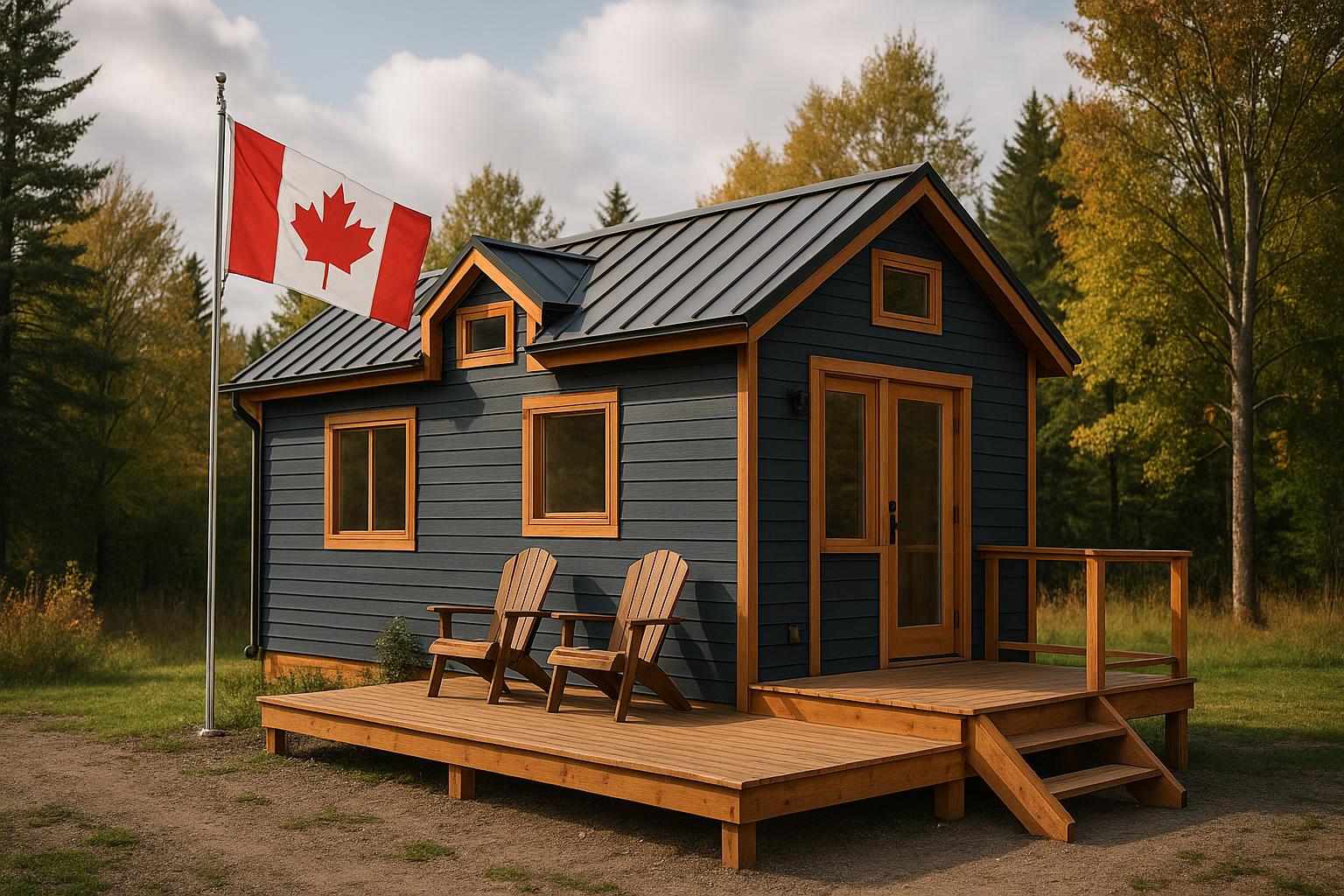
Estimated reading time: 8 minutes
Budget Tiny Home Canada: Cost-Saving Hacks, ADU Construction Tips & Affordable Housing 2025
Key Takeaways
- Discover cost-saving hacks and smart material choices to build affordable, climate-resilient tiny homes.
- Learn how Canadian tiny homes and ADUs can provide flexible housing solutions even with tight budgets.
- Understand the importance of regulatory compliance, proper permitting, and local sourcing in creating sustainable homes.
Table of Contents
- Affordable Housing 2025: Canadian Trends
- What Defines a Budget Tiny Home in Canada?
- Cost-Saving Hacks for a Budget Tiny Home
- ADU Construction Tips for Canadian Homes
- Case Studies: Real Canadian Tiny Homes & ADU Success Stories
- Planning & Budgeting for Your Tiny Home or ADU
- Conclusion
- Frequently Asked Questions
Budget tiny home Canada is now a top search term for good reason. As home ownership costs skyrocket, more Canadians are searching for creative ways to secure affordable, flexible, and sustainable housing. In 2025, Canadian tiny homes and Accessory Dwelling Units (ADUs) are gaining momentum as game-changing solutions—delivering extra living space without causing massive debt.
In this guide, you’ll find practical cost-saving hacks, actionable ADU construction tips, and detailed advice tailored to Canadian building challenges. Whether you are a first-time homeowner, an investor, or supporting extended family needs, this article provides strategies to achieve your affordable housing 2025 goals.
Affordable Housing 2025: Canadian Trends and the Rise of Small Homes
The affordable housing 2025 landscape in Canada is shaped by high property prices and rapid urban growth. Tiny homes and ADUs offer promising alternatives:
- Tiny homes: With skyrocketing home prices, these compact dwellings provide an affordable, self-contained living option for singles, small families, and retirees.
- ADUs: Also known as backyard suites or laneway houses, these secondary units boost property density and can serve as rental income sources or extra living space.
-
Regulatory movement: Municipalities are updating bylaws to support these solutions. For more details, see Tiny Home Certification Canada 2025,
Tiny Homes Legal in Canada, and
Canada Tiny House News. Additional insights can be found at
Affordable Housing Solutions and
Affordable Housing Social Equity.
Together, Canadian tiny homes and ADUs align with urban planning priorities of increased density, a smaller carbon footprint, and greater affordability.
What Defines a Budget Tiny Home in Canada?
Size and Space
- Most budget tiny homes in Canada range from 200 to 400 square feet.
- Local bylaws may require a minimum size—often around 400 sq. ft. as suggested by regional building codes.
-
Always verify local rules. For example, read more on Tiny Homes Legal in Canada,
Permitting and Regulations, and
Tiny House Builders Guide. - Additional regional guidance is available at
Ontario Tiny Home Permits and
BC Tiny Home Permits.
Canadian Building Standards
- Permits & Compliance: Adhere to local bylaws and the National Building Code or provincial codes, along with CSA standards.
- Zoning & Placement: Confirm that your lot permits tiny homes or ADUs by checking local zoning laws.
- Utility Hookups: Professional installation of plumbing, electrical, and sewer systems is essential.
Climate-Resilient Design
- Invest in heavy insulation, double-glazed windows, and durable exteriors to withstand Canadian winters.
- Design the building envelope with air barriers and high thermal performance materials.
Permitting & Bylaws
- Prepare comprehensive documentation including plans, inspections, and proof of code compliance.
- Non-compliance can lead to fines or forced removal, so strictly adhere to regulations.
A Canadian tiny home that meets all standards ensures affordable shelter while prioritizing safety and efficiency. For further reading, visit
Tiny Homes Legal in Canada,
Permitting Insights,
Tiny House Builders Guide,
Canada Tiny House News,
Tiny Home Certification Canada 2025, and
Legal Requirements for Tiny Homes.
Cost-Saving Hacks for a Budget Tiny Home in Canada
Smart Material Choices
- Opt for engineered wood, SIPs, or metal framing which are cost-effective and quick to install.
-
Use recycled & repurposed materials such as salvaged wood, reclaimed windows, and surplus fixtures. Read about these benefits at
Reclaimed Materials for Tiny Homes.
DIY vs. Professional Trades
- Take on manageable DIY projects like painting, drywall finishing, and installing built-in shelves.
- Always hire certified professionals for critical systems like electrical, plumbing, and HVAC to ensure safety and compliance.
Efficiency Upgrades for Canadian Climates
- Install high-grade insulation (minimum R-24 for walls and R-40 for roofs) and choose Energy Star rated windows and doors.
- Use air-sealing techniques such as caulking, weatherstripping, and spray foam to keep energy costs low.
- Consider a Heat Recovery Ventilator (HRV) for maintaining indoor air quality during harsh winters.
Local Sourcing and Labour
- Purchase supplies from local vendors to cut down on delivery fees and support local businesses.
-
Hire neighborhood tradespeople who understand local building codes. More details can be found at
Tiny Home Certification Canada 2025,
Tiny Home Builder Guide, and
Find a Contractor.
ADU Construction Tips for Canadian Homes in 2025
What Is an ADU?
An Accessory Dwelling Unit (ADU) is a self-contained secondary living space—such as a backyard cottage, laneway suite, or converted garage—that offers flexible housing options for family, guests, or rental income.
Construction Strategies
- Modular or Prefab Builds: Factory pre-built modules can be quickly assembled on-site, reducing labor costs and weather-related delays.
- Standardized Designs: Use approved floorplans to simplify permitting and shorten approval times.
-
Flexible Spaces: Incorporate moveable partitions or Murphy beds so spaces easily transition between rental, guesthouse, or studio uses. See more at
Prefab vs. Custom ADU Builds and
Accessory Dwelling Units Guide.
Navigating Canadian Permitting
- Research local municipal rules regarding parking, utility connections, and size limits.
- Submit detailed plans including architectural drawings, CSA certifications, and utility documents to secure approval.
-
Engage with local planning officials early to avoid red tape. Additional guidelines can be found at
Tiny Homes Legal in Canada,
Tiny Home Certification Canada 2025,
Ontario ADU Permitting,
BC ADU Permitting, and
Alberta ADU Permitting.
Design Tips for Canadian ADUs
- Use built-in solutions like fold-down beds and wall-mounted tables to maximize the limited space.
- An open layout with large windows not only provides natural light but also creates a feeling of spaciousness.
-
Invest in soundproofing between the main house and the ADU for improved privacy. Explore options at
Soundproofing for Tiny Homes,
Noise Reduction in Canadian Housing, and
Privacy Solutions for Tiny Homes.
Case Studies: Real Canadian Tiny Homes & ADU Success Stories
Ontario Tiny Home Success
- A couple built a 350 sq. ft. tiny home near Kingston using reclaimed barn wood siding and recycled flooring.
- They installed spray foam insulation DIY-style for cost savings while hiring professionals for critical systems to meet CSA standards.
- Local trades, correct permitting, and climate-proofing were central to their success. More details can be found at
Canadian ADU Success Stories and
Reclaimed Materials in Tiny Homes.
Vancouver Laneway ADU Project
- A Vancouver homeowner added a 400 sq. ft. laneway suite using a prefabricated shell.
- DIY work complemented professional installations for HVAC and electrical, ensuring both economy and quality.
- Savings were enhanced by sourcing second-hand finishes from local outlets. For inspiration, check out
ADU Investment Guide.
Planning and Budgeting for Your Tiny Home or ADU in Canada
Step 1: Research and Confirm Local Rules
- Consult local building departments and online portals to learn about zoning, certifications, and permit costs. Refer to
Tiny Home Certification Canada 2025 and
Tiny Homes Legal.
Step 2: Set Priorities
- Safety and compliance should be at the forefront: budget for the building envelope and critical systems before aesthetics.
Step 3: Estimate All Costs
- Include expenses for permitting, inspections, site preparation, supplies, professional labor, and a contingency fund (10-15%).
Step 4: Plan for DIY & Professional Tasks
- Divide the project into phases and decide which tasks can be DIY and which require certified trades.
Step 5: Track Every Expense
- Use spreadsheets or budgeting tools to monitor spending and keep all documentation of permits and invoices.
Avoid common pitfalls such as under-budgeting for climate-related upgrades, overlooking permitting details, or over-customizing unique features.
Conclusion: Making Budget Tiny Home Canada a Reality
Canadian tiny homes and ADUs are redefining affordable housing 2025 in Canada. With strategic cost-saving hacks, lean construction techniques, and diligent budgeting, you can make home ownership or rental income a reality.
Remember: Thorough planning, early engagement with local authorities, and mixing recycled materials with modern technology are key to success. Start your journey today by consulting local builders and exploring available resources.
Frequently Asked Questions
-
Q: What is the typical size of a budget tiny home in Canada?
A: Most budget tiny homes range from 200 to 400 square feet, though local regulations may require a minimum size. -
Q: Do I need professional help with ADU installations?
A: Yes. While DIY work is possible for non-critical aspects, hiring certified professionals for electrical, plumbing, and HVAC is essential. -
Q: How can I ensure my tiny home meets Canadian building standards?
A: Check with local building departments, adhere to the National Building Code or provincial codes, and review resources like
Tiny House Builders Guide.

Leave a Reply